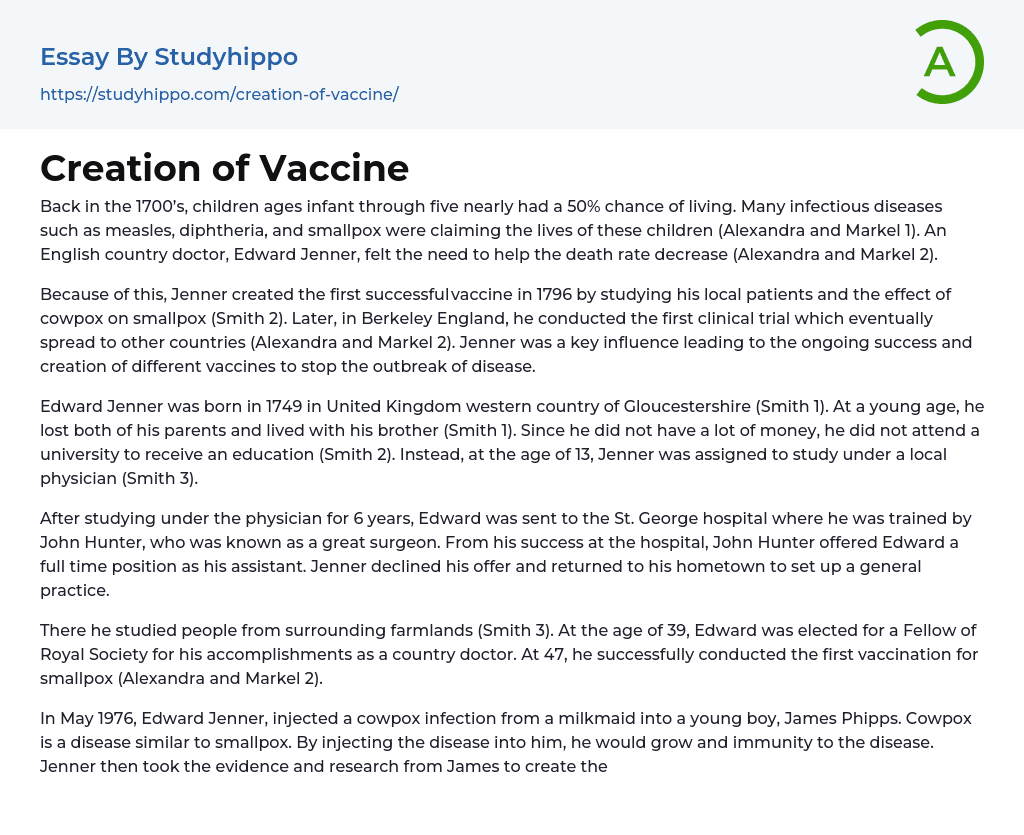In the 1700s, nearly 50% of children aged between infancy and five years old managed to survive. Measles, diphtheria, and smallpox were significant contributors to child mortality (Alexandra and Markel 1). Edward Jenner, an English rural physician, recognized the necessity of reducing death rates (Alexandra and Markel 2).
In 1796, Edward Jenner developed the first successful vaccine by examining his local patients and studying the effects of cowpox on smallpox (Smith 2). He later conducted the initial clinical trial in Berkeley England, which eventually spread to other countries (Alexandra and Markel 2). Jenner's influence played a crucial role in the ongoing success and advancement of various vaccines used to combat disease outbreaks. Born in Gloucestershire, United Kingdom in 1749, Jenner faced early loss of both parents and resided with his brother (Smith 1).
Due to his lack of financial means, he made the
...decision to forgo attending university (Smith 2). Instead, at the age of 13, Jenner was placed under the mentorship of a local physician (Smith 3). After spending six years with this physician, Edward was then sent to St. George hospital where he received training from renowned surgeon John Hunter. Recognizing Edward's achievements at the hospital, John Hunter suggested that Edward become his permanent assistant.
Jenner declined his offer and returned to his hometown to establish a general practice. There he studied people from surrounding farmlands (Smith 3). At the age of 39, Edward was elected as a Fellow of the Royal Society for his achievements as a country doctor. At 47, he successfully performed the first vaccination for smallpox (Alexandra and Markel 2). In May 1976, Edward Jenner
injected a cowpox infection from a milkmaid into a young boy, James Phipps.
Cowpox is a disease comparable to smallpox. By injecting cowpox into individuals, they would develop immunity to the disease. Jenner then utilized James' evidence and research to develop the vaccine for preventing the spread of smallpox (Riedel 3). The British public greatly admired Edwards' work and provided him with one million dollars in funding to continue creating vaccines (Alexandra and Markel 4). In the 1800s, the royal family's praise for vaccines helped raise awareness about their capabilities.
According to Alexandra and Markel (4), over a hundred thousand people in Europe were vaccinated. Benjamin Waterhouse, a Physics teacher from Harvard University, received a supply of the vaccination and was one of the first to introduce it to the citizens of the United States. He then persuaded President Thomas Jefferson to take some for Virginia, as reported by the Natural Research Council.
The introduction of the vaccination took place in the United States. This led to the worldwide recognition of the vaccine program, which was established by the World Health Organization (WHO) and the United Nations Children’s Fund (UNICEF). The WHO initiated the Expanded Programme on Immunization (EPI) in 1974 to increase vaccine rates for children in various countries (Alexandra and Markel 4). Along with other countries, England experienced a rapid spread of vaccinations. Dr.
George Pearson and Dr.
Williams Woodville extensively promoted the
vaccinations
in their practices (Riedel 3). London became aware of the
vaccine
thanks to Henry Cline who received a supply from Jenner (National Research Council). It also began to spread through various European countries (Riedel 3). During the 1960’s and 1970’s, Donald Henderson led a smallpox campaign to raise awareness of
vaccines
worldwide (Alexandra and Markel 5). The pertussis
vaccine
was developed in the 1920’s due to the awareness of the smallpox
vaccine
(National Research Council).
The creation of the vaccine for whooping cough was due to the inability to determine its cause. The vaccine was developed using whole, dead organisms (National Research Council). In 1955, production of vaccines temporarily ceased after two hundred children contracted diseases from the vaccinations (Alexandra and Markel 5). However, with new modifications, vaccination rates began to increase again (Alexandra and Markel 5). The measles vaccination was introduced in the United States during the 1960s (Alexandra and Markel 6). As a result of this vaccination, the number of measles outbreaks decreased from 894,134 cases to 1,497 cases and fatalities reduced from 2,250 deaths to just 2 deaths (National Research Council).
The National Vaccine Advisory Board acknowledged the significance of vaccines in 2003 and called for increased funding for them (Alexandra and Markel 5). The progress achieved through previous vaccines now serves as inspiration for ongoing efforts to combat diseases like smallpox, polio, and measles (Alexandra and Markel 5). Since the creation of vaccines, more than twenty have been developed to prevent different
diseases such as chicken pox, hepatitis, and herpes (National Research Council). Edward Jenner utilized his knowledge and conducted scientific experiments to create the initial effective vaccine. Edward Jenner's observation about cowpox transforming into smallpox played a crucial role in raising global awareness about vaccines (Alexandra and Markel 6).
Several doctors distributed Jenner's vaccination to their patients, with some modifying the vaccines for increased effectiveness (Riedel 2). Edward Jenner's dedication to the first successful vaccine has led to ongoing development and usage of vaccines in treating various diseases (National Research Council).
- alternative medicine essays
- Aspirin essays
- Cannabis essays
- Cardiology essays
- Cloning essays
- Dentist essays
- drugs essays
- Hemoglobin essays
- Medical essays
- Medical Ethics essays
- Organ Donation essays
- Patient essays
- Pharmacology essays
- Plastic Surgery essays
- Surgery essays
- Therapy essays
- Vaccines essays




